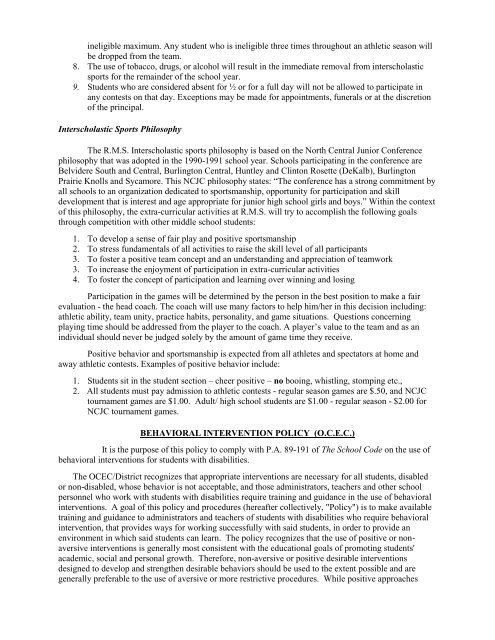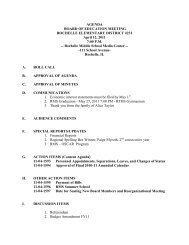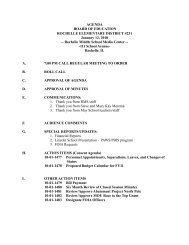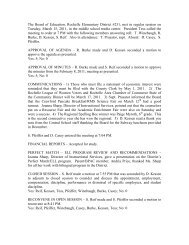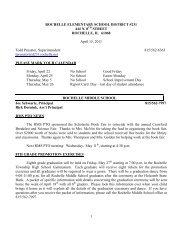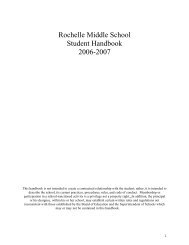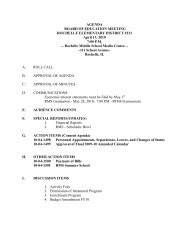Rochelle Middle School - Rochelle Community Consolidated School ...
Rochelle Middle School - Rochelle Community Consolidated School ...
Rochelle Middle School - Rochelle Community Consolidated School ...
- No tags were found...
Create successful ePaper yourself
Turn your PDF publications into a flip-book with our unique Google optimized e-Paper software.
ineligible maximum. Any student who is ineligible three times throughout an athletic season willbe dropped from the team.8. The use of tobacco, drugs, or alcohol will result in the immediate removal from interscholasticsports for the remainder of the school year.9. Students who are considered absent for ½ or for a full day will not be allowed to participate inany contests on that day. Exceptions may be made for appointments, funerals or at the discretionof the principal.Interscholastic Sports PhilosophyThe R.M.S. Interscholastic sports philosophy is based on the North Central Junior Conferencephilosophy that was adopted in the 1990-1991 school year. <strong>School</strong>s participating in the conference areBelvidere South and Central, Burlington Central, Huntley and Clinton Rosette (DeKalb), BurlingtonPrairie Knolls and Sycamore. This NCJC philosophy states: “The conference has a strong commitment byall schools to an organization dedicated to sportsmanship, opportunity for participation and skilldevelopment that is interest and age appropriate for junior high school girls and boys.” Within the contextof this philosophy, the extra-curricular activities at R.M.S. will try to accomplish the following goalsthrough competition with other middle school students:1. To develop a sense of fair play and positive sportsmanship2. To stress fundamentals of all activities to raise the skill level of all participants3. To foster a positive team concept and an understanding and appreciation of teamwork3. To increase the enjoyment of participation in extra-curricular activities4. To foster the concept of participation and learning over winning and losingParticipation in the games will be determined by the person in the best position to make a fairevaluation - the head coach. The coach will use many factors to help him/her in this decision including:athletic ability, team unity, practice habits, personality, and game situations. Questions concerningplaying time should be addressed from the player to the coach. A player’s value to the team and as anindividual should never be judged solely by the amount of game time they receive.Positive behavior and sportsmanship is expected from all athletes and spectators at home andaway athletic contests. Examples of positive behavior include:1. Students sit in the student section – cheer positive – no booing, whistling, stomping etc.,2. All students must pay admission to athletic contests - regular season games are $.50, and NCJCtournament games are $1.00. Adult/ high school students are $1.00 - regular season - $2.00 forNCJC tournament games.BEHAVIORAL INTERVENTION POLICY (O.C.E.C.)It is the purpose of this policy to comply with P.A. 89-191 of The <strong>School</strong> Code on the use ofbehavioral interventions for students with disabilities.The OCEC/District recognizes that appropriate interventions are necessary for all students, disabledor non-disabled, whose behavior is not acceptable, and those administrators, teachers and other schoolpersonnel who work with students with disabilities require training and guidance in the use of behavioralinterventions. A goal of this policy and procedures (hereafter collectively, "Policy") is to make availabletraining and guidance to administrators and teachers of students with disabilities who require behavioralintervention, that provides ways for working successfully with said students, in order to provide anenvironment in which said students can learn. The policy recognizes that the use of positive or nonaversiveinterventions is generally most consistent with the educational goals of promoting students'academic, social and personal growth. Therefore, non-aversive or positive desirable interventionsdesigned to develop and strengthen desirable behaviors should be used to the extent possible and aregenerally preferable to the use of aversive or more restrictive procedures. While positive approaches


